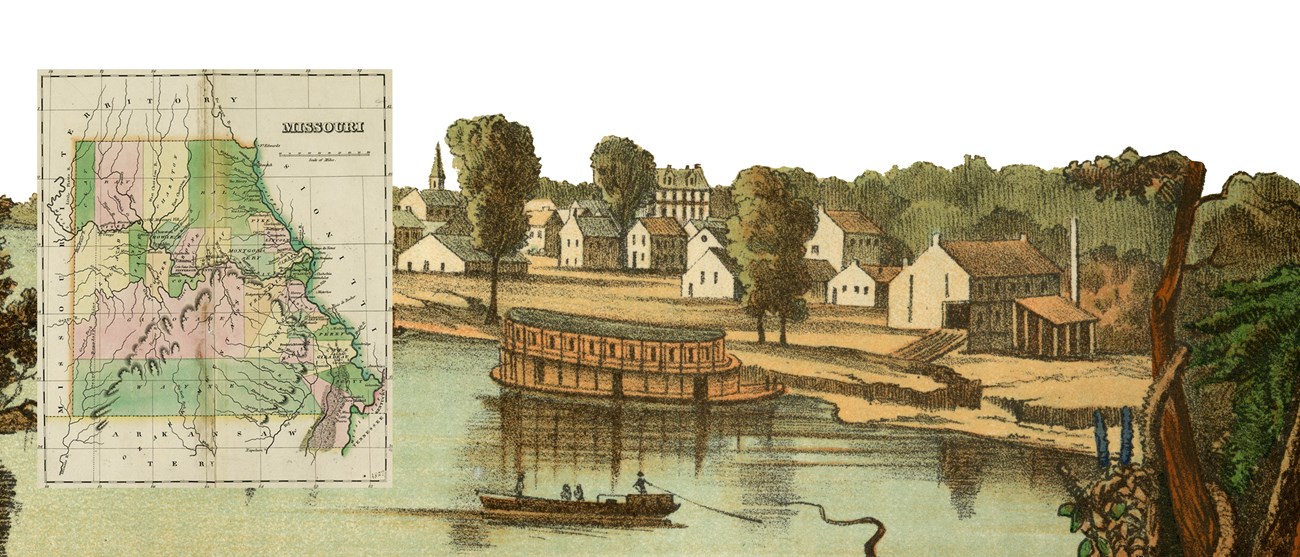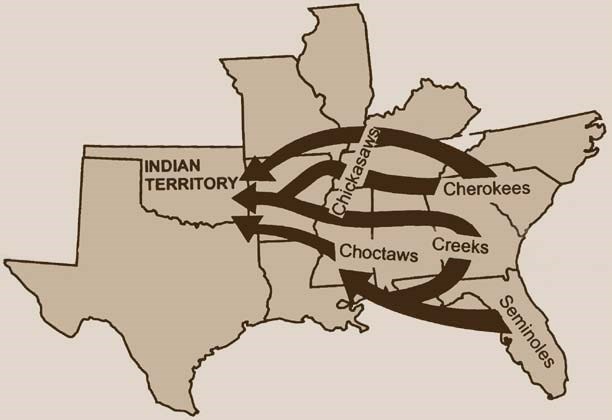Last updated: November 12, 2021
Article
New Madrid and the Trail of Tears
The Cherokee on the water route of the Trail of Tears passed by New Madrid, Missouri, on their way to Indian Territory (present-day Oklahoma).
This information is available in exhits that are located on the levee in New Madrid.

They Passed This Way
Home to thousands of men, women, and children, the Cherokee Nation once spread across parts of Georgia, North Carolina, Tennessee, and Alabama. The 1830 Indian Removal Act required that the Cherokee surrender their land and move west.
In 1838, more than 15,000 Cherokee began their trek west from their eastern homeland to Indian Territory (present-day Oklahoma) over the “Trail of Tears.” They traveled by roads and rivers, including the stretch of the Mississippi River near New Madrid. More than 1,000 died during the journey westward, and more than 4,000 died as a result of their forced migration.
I have no more land. I am driven away from home, driven up the red waters, let us all go, let us all die together and somewhere upon the banks we will be there.
- From Sin-e-cha’s Song, heard on removal boats along the Trail of Tears.

Courtesy of the State Historical Society of Missouri
Water Route to Indian Territory
New Madrid was a remote stretch of the Mississippi River when steamboats of Cherokee passed by on their way west to Indian Territory on the water route of the Trail of Tears. River traffic in 1838 was limited to the daylight hours because of snags and shifts in the river. It is probable that one or more of the steamboats stopped at New Madrid because there were not many places to aquire supplies, including food for the travelers as well as wood and water for the steam engines.
Local pilots were often hired to take boats through nearby stretches of the river. Physicians who lived here may have tended to Cherokee sick from exhaustion and the close quarters onboard ship. At the time, the town of New Madrid had only 317 residents, 159 of whom were enslaved.
The steamer Warren brought news...of the loss of the steam-boat Monmouth, and the death of at least onehalf of her infamously crowded passengers. This fatal, and most appalling, accident arose from a collision between these two boats; but from the best intelligence we can procure, the blame rests upon the Monmouth. ... Six hundred (Creek) were jammed into this boat... and three hundred have perished.
- Arkansas Gazette, November 28, 1837
Dangers of Water Travel along the Trail of Tears
Few groups of Cherokee traveled by water. After hearing of the diffi culties faced by military-led groups that had traveled the water route, Cherokee leaders petitioned for permission to manage the removal of their own people.
They decided to remove over land routes to avoid the dangers of travel by boat, including the quick spread of sickness onboard, the fear of disease along the river lowlands, and unpredictable water levels and weather patterns.

Steamboats pulling long flatboats and keelboats were common and part of a bustling scene on the Arkansas and Mississippi rivers in the 1830s.

NPS Image
Federal Indian Removal Policy
Federal Indian removal policy aroused fierce and bitter debate. Supporters of the policy claimed it was a benevolent action to save the tribes east of
the Mississippi River from being overwhelmed and lost in the onslaught of an expanding American population. Opponents decried its inhumanity and the tragic consequences it had for the Indian peoples. One thing was certain; removal freed millions of acres of desired Indian lands for use by white settlers.
The Indian Removal Act of 1830 resulted in the removal of thousands of American Indians from their ancestral lands for new homes in Indian Territory
(present-day Oklahoma). They traveled by existing roads and rivers. Many groups, hoping to avoid the disease and heat of summer travel, left in the fall and instead faced treacherous winter weather. Many died during the ordeal of the Trail of Tears.
Today
Despite the hardships of the journey, members of the five removed tribes established new lives in the West. They stand as successful sovereign nations, proudly preserving cultural traditions, while adapting to the challenges of the 21st century.
Cherokee who survived the Trail of Tears created a new sovereign nation in present-day Oklahoma. Some Cherokee remained in North Carolina and due to a special exemption formed the Eastern Band of Cherokee Indians

NPS Image


